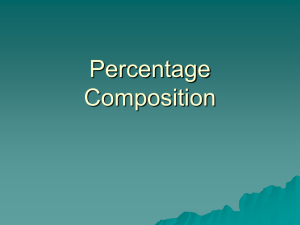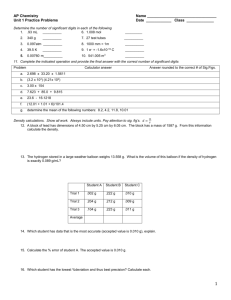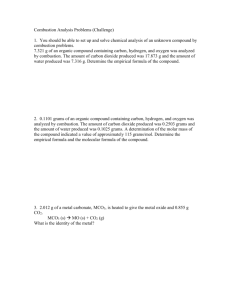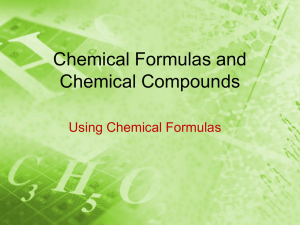here
advertisement
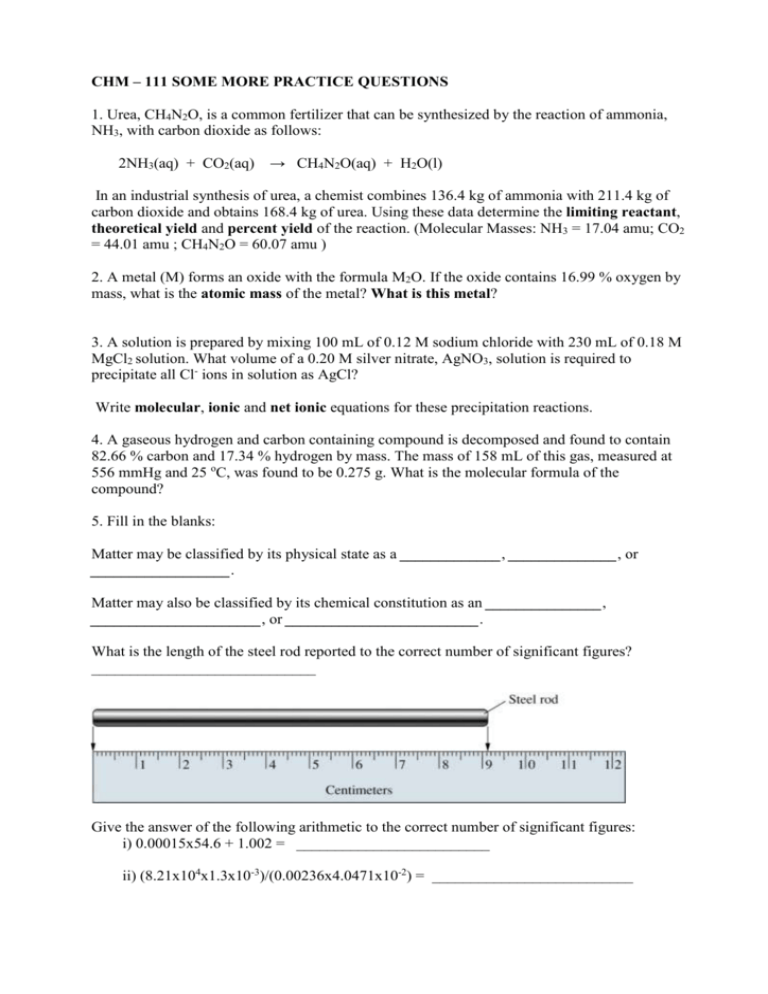
CHM – 111 SOME MORE PRACTICE QUESTIONS 1. Urea, CH4N2O, is a common fertilizer that can be synthesized by the reaction of ammonia, NH3, with carbon dioxide as follows: 2NH3(aq) + CO2(aq) → CH4N2O(aq) + H2O(l) In an industrial synthesis of urea, a chemist combines 136.4 kg of ammonia with 211.4 kg of carbon dioxide and obtains 168.4 kg of urea. Using these data determine the limiting reactant, theoretical yield and percent yield of the reaction. (Molecular Masses: NH3 = 17.04 amu; CO2 = 44.01 amu ; CH4N2O = 60.07 amu ) 2. A metal (M) forms an oxide with the formula M2O. If the oxide contains 16.99 % oxygen by mass, what is the atomic mass of the metal? What is this metal? 3. A solution is prepared by mixing 100 mL of 0.12 M sodium chloride with 230 mL of 0.18 M MgCl2 solution. What volume of a 0.20 M silver nitrate, AgNO3, solution is required to precipitate all Cl- ions in solution as AgCl? Write molecular, ionic and net ionic equations for these precipitation reactions. 4. A gaseous hydrogen and carbon containing compound is decomposed and found to contain 82.66 % carbon and 17.34 % hydrogen by mass. The mass of 158 mL of this gas, measured at 556 mmHg and 25 oC, was found to be 0.275 g. What is the molecular formula of the compound? 5. Fill in the blanks: Matter may be classified by its physical state as a _____________, ______________, or __________________. Matter may also be classified by its chemical constitution as an _______________, ______________________, or _________________________. What is the length of the steel rod reported to the correct number of significant figures? _____________________________ Give the answer of the following arithmetic to the correct number of significant figures: i) 0.00015x54.6 + 1.002 = _________________________ ii) (8.21x104x1.3x10-3)/(0.00236x4.0471x10-2) = __________________________ Robert Millikan performed a serious of oil-drop experiments in which he obtained the ________________ _____ the electron. The name of the compound H2SO4 is _______________ _____________. The name of the compound FeBr3 is __________________ _______________ or _________________ _________________. The formula of potassium perchlorate is __________________________. The number of atoms in 0.025 mole of Mg(OH)2 is ____________________. NaCl(aq) + AgNO3(aq) → AgCl(s) + NaNO3(aq) is a ___________________ reaction. The oxidation number of chlorine in HClO3 is ____________. The substances that dissolve in water to give ions are called ______________________. 6. Name or give the formula of the following: Na2SO4 : ______________________________________ b) CaS : _______________________________________ c) ammonium carbonate :_______________________________ d) nitric acid : _______________________________ 7. Combustion analysis of a 13.42 g sample of equilin (which contains only carbon, hydrogen and oxygen) produced 39.61 g CO2 and 9.01 g H2O. The molar mass of equilin is 268.34 g mol-1. Find the molecular formula of equilin. (Atomic masses(in amu): C = 12.01; O = 16.00 ; H = 1.01) 8. Jewelry is usually made of an alloy of gold and silver. Suppose a piece of such jewelry, weighing 9.58 g, has a volume of 0.675 cm3. Giving the density of pure gold as 19.3 g cm-3 and the density of pure silver as 10.5 g cm -3, calculate the mass percentage of gold in this piece of jewelry. 9. The atomic mass of silicon is 28.09 amu. It has three isotopes with isotopic masses as, 27.977 amu, 28.976 am. and 29.974 amu. The fractional abundance of the lightest isotope is 0.9221. Calculate the fractional abundances of the other two isotopes. Isotope Silicon-28 Silicon-29 Silicon-30 Isoptopic Mass(amu) 27.977 28.976 29.974 Fractional abundance 0.9221 ? ? 10. Suppose that a metal, X, forms a solid oxide with the formula XO3, and the oxide reacts with H2(g) to form the free metal and H2O(l). a) Write the chemical equation for the reaction. 2 b) A 3.31 g sample of XO3(s) reacts with excess H2(g) to yield 1.24 g H2O(l). What is the formula mass of XO3? c) What is the metal X? 11. Thiophene is compound which contains carbon, hydrogen and sulphur elements. Combustion of 1.505 g sample of thiophene in excess oxygen, yielded 3.149 g CO2, 0.645 g H2O, and 1.146 g SO2. By using these data determine the empirical (simplest) formula of thiophene. Show your work. 12. Commercially iron is obtained from the reduction of hematite, Fe2O3 : Fe2O3(s) + 3CO(g) 2Fe(s) + 3CO2(g) In a given experiment 6.50 g of Fe was produced when 12.77g of Fe2O3 was reacted with 5.00 L of CO at 1.00 atm pressure and 25oC. What is the percent yield of this reaction? (The density of CO at 1.00 atm and at 25o C is 1.15 g/L ) 13. Classify the following reactions as Precipitation reaction, Acid-Base reaction, or Oxidationreduction reaction: 2C4H10(g) + 13O2(g) → 8CO2(g) + 10H2O(g) _____________________________ HCN(aq) + NH3(aq) → NH4+(aq) + CN-(aq) _______________________________ MgCl2(aq) + 2AgNO3(aq) →Mg(NO3)2(aq) + 2AgCl(s) ___________________ 2Na(s) + Cl2(g) → 2 NaCl(s) _______________________ 14. The density of an unknown gas is 1.25 g/L at 20 oC and 1.00 atm. i) Calculate the number of gas molecules present in 1.00 cm3, under these conditions. ii) Calculate the molecular mass of this gas. 15. The heat of combustion of acetylene, C2H2(g), is -1299.5 kJ/mol. a) Assuming that the combustion products are CO2(g) and H2O(l), write a balanced chemical equation for the combustion reaction . b) Given that the enthalpy of formation of CO2(g) is -393.5 kJ/mol and that of H2O(l) is -285.8 kJ/mol, calculate the enthalpy of formation of C2H2(g). 16. The monatomic ions A2+ and B3- are isoelectronic. If the atomic number of A is 20, write the set of four quantum numbers for all the valence electrons of neutral atom B. Electron n l ml ms . 17. Give the correct increasing order (lowest first) of the first ionization energy for the following elements. i) Na, Li , Cs, K, Rb ii) Al, Si, Cl , P, Mg, S 3 18. Total pressure of a gas mixture, which contains equal masses of O2(g), N2(g), and Ne(g), is 1.40 atm. a) Calculate the mole fraction of each gas. b) What are the partial pressures of each gas? 19. Suppose you have 200.0 mL water in a glass at 25.0 oC and you would like to cool it down to 10 oC before you drink it by adding ice at 0 oC. Assuming that no energy will be lost to the surroundings, calculate how many grams of ice you need to add to your glass. (Enthalpy of fusion, ∆Hfus, for ice is 6.01 kJ/mol) 20. When a helium atom absorbs light at 58.44 nm, an electron is promoted from the 1s orbital to a 2p orbital yielding excited state helium. Given that the ionization energy of (ground state) helium is 2372 kJ/mol, find the longest wavelength of light that could eject an electron from the excited state helium atom. 21. Write the electron configuration of phosphorus, P, and answer the following: i) Is phosphorus atom paramagnetic or diamagnetic? ii) How many valence electron does it have? iii) Write the four quantum numbers for all its valence electrons.(Fill in table below.) Valence electron n l ms ml 1. 2. 3. . . iv) How many electrons in P atom have its mℓ quantum number equal to 0 (zero) as one of their four quantum numbers? 22. Electron configuration of Curium, 1s2 2s2 2p6 3s2 3p6 4s2 3d10 4p6 96Cm, is given below: 5s2 4d10 5p6 6s2 4f 145d10 6p6 7s2 5f7 6d1 Find the number of electrons that have the following specified quantum number(s), as part of their full set of four-quantum numbers: I) n = 3, l=2 ________________ II) n = 5 _________________ III) n =4, l= 3 _________________ IV) l = 3 __________________ V) n = 2, l= 1 ml = -1, ms = +1/2 _________________________ 23. Define the following terms very briefly ( you can also use equations to help your definition): a) specific heat capacity : b) thermochemical equation: 4 c) molar heat capacity : d) de Broglie relation : e) first ionisation energy : f) electron affinity : g) bond energy : 24. An argon ion laser outputs 5.00W of continuous power at a wavelength of 532 nm. If the diameter of such a laser beam is 5.5 mm and if it is directed to a pinhole with a diameter of 1.2 mm, determine the number photons that will pass through the pinhole in one second.( 1 W = 1 Joules/second ) 25. A sample of ethanol-water mixture has a volume of 54.2 mL and a mass of 49.6 g. What is the percentage of ethanol by mass in this mixture? The density of ethanol is 0.789 g/mL and that of water is 0.998 g/mL. Show your work. 26. Draw the Lewis structure of SOCl2 27. Estimate the enthalpy change for the addition of chlorine to ethene as represented by CH2 CH2 + Cl2 CH2CH2Cl2 Show your work. 28. Calculate the energy emitted when 1.0 g of hydrogen gas undergoes a transition from n=4 to n=1. Show your work. 5. A sample of hydrogen was collected over water by displacing water at 23.0°C at an atmospheric pressure of 735 mmHg. The volume was observed to be 568 mL. After water vapour is removed, what volume would the hydrogen gas occupy under the same conditions? The vapor pressure of water is 21 mmHg at this temperature. Show your work. 29. What is the molar heat of combustion of benzene, C6H6, if combustion of 1.00 g of this compound causes a temperature rise of 5.18 ºC in bomb calorimeter that has a heat capacity of 8.07 kJ/ºC? Show your work. 30. There are four naturally occurring isotopes of strontium, Sr. Given the following table, compute the atomic mass of natural strontium. Show your work. Percentage Abundance, % 0.56 9.86 86.909 87.906 Isotopic mass, amu 83.913 85.909 87.00 82.58 31. Which of the following bonds is most polar? C-O, C-H, H-Br? Explain. 5 32. Fumaric acid occurs in many plants. It contains, by mass, 41.4% carbon, 3.4% hydrogen and the rest is oxygen. A 0.050 mol of the compound weighs 5.80 g. Determine the molecular formula of the compound. Show your work. 33. Suppose you are given two identical cubic boxes with 8.0 cm on each dimension. You are also given several spheres that are 1.6 cm in diameter and several cubes that are 1.6 cm on each edge. You are then asked to fill the first box with the spheres and the other with the cubes. Assuming that both the cubes and the spheres are made of the same material, which box will be heavier? Show your work. 34. A 15.5-g sample of a metal alloy is heated to 98.9°C and then dropped into 25.0 g of water in a calorimeter. The temperature of water rises from 25.5°C to 25.7°C. Assuming that the calorimeter does not absorb any heat, calculate the specific heat of the alloy. Specific heat of water is 4.180 J/°C g. Show your work. 35. Laughing gas is dinitrogen oxide, N2O. One of the nitrogen atoms is the central atom. What is the geometry of the molecule? Is it polar? Show your work. 36. What is the wavelength of a neutron travelling at a speed of 41.15 km/s? Show your work. 37. What is the shape of the electron pair arrangement around the central iodine atom in the ion? Show your work. 6

